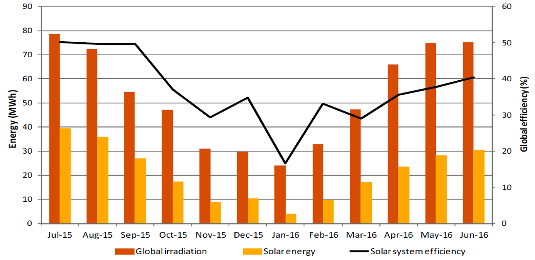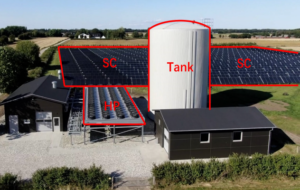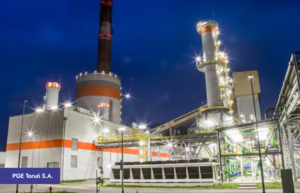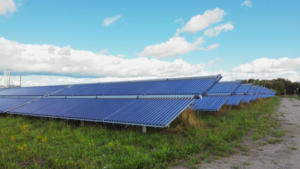

France: Is This The New Solar District Heating Country?
 After France had become involved in a couple of EU-supported projects as a newcomer, the country is now ready for take-off in the solar district heating (SDH) market. Monitoring data from the first two French pilot plants show performance to be quite good and the systems to be highly reliable. The chart depicting the performance of the 458 m2 evacuated tube collector field in Balma-Gramont was presented by Fabrice Renaud, Research Engineer in the R&D centre Cylergie at the French group Engie, during the 4th International Solar District Heating Conference in Billund, Denmark. There is also a new strategy document being devised to advance the development of SDH in the French region of Auvergne – Rhône-Alpes.
After France had become involved in a couple of EU-supported projects as a newcomer, the country is now ready for take-off in the solar district heating (SDH) market. Monitoring data from the first two French pilot plants show performance to be quite good and the systems to be highly reliable. The chart depicting the performance of the 458 m2 evacuated tube collector field in Balma-Gramont was presented by Fabrice Renaud, Research Engineer in the R&D centre Cylergie at the French group Engie, during the 4th International Solar District Heating Conference in Billund, Denmark. There is also a new strategy document being devised to advance the development of SDH in the French region of Auvergne – Rhône-Alpes.Chart: Engie Group
First SDH experiences in France
Renaud emphasised the satisfactory results in specific solar yield of between 550 and 560 kWh/m2 from the plant in Balma-Gramont, near Toulouse in southern France. The solar fraction, however, dropped from almost 6 % to 4.5 % because of an increased demand in the district heating network. The solar plant demonstrated a high degree of reliability and did not cause any major problems (stagnation never occurred). Even so, it would be advantageous to improve the system and reduce the power consumption of auxiliary components, something that is still too high (about 17 kWh per MWh of generated heat).
Renaud also presented the monitoring outcomes of the 300 m2 flat plate collector SDH plant in Juvignac in southern France. Although the annual solar yield matches up with design values (about 720 kWh/m2), the solar fraction is below expectations (about 4 % instead of 5.5 %) – again, because of higher demand from power consumers. This plant did experience some stagnation because of interruptions in the DH network: One option to avoid this problem in the future would be to include a tank for storing additional solar heat.
A national survey carried out by the Regional Energy and Environment Agency of Auvergne – Rhône-Alpes (RAEE) found that 800 DHC systems were in operation countrywide, with around 15 % of the district heating demand being covered by renewable energy sources and 25 % by waste heat, at an average cost of heat of 70 EUR/MWh. The number of SDH installations was said to be three existing ones and two under construction. The SDH collector area expected to be installed by 2030 was 800,000 m², plus an increase by a factor of 5 in the use of RES in district heating (from 0.7 MTOE to 3.4).
Policy matters too
Beyond the pilot plants and their crucial role as “technology showrooms”, there should also be proper policies in place to promote SDH and in many cases the best place to do this is at regional level. In the framework of Horizon 2020 project SDHp2m…from Policy to Market, the French region of Auvergne – Rhône-Alpes is currently drafting a strategy document to develop SDH locally in cooperation with RAEE, the National Solar Energy Institute (INES) and CEA Tech.
RAEE’s starting point was a SWOT analysis – which is short for Strengths, Weaknesses, Opportunities and Threats. The results highlighted the typical strengths of solar thermal – being a freely available resource and a no-emission “fuel” – as well as its opportunities, in line with current developments in the district heating sector, such as in low-temperature systems, long-term storage, energy efficiency, etc. “Regarding drawbacks, we looked at the space requirements as the main weakness and at building heat regulations, which have not been yet extended to include SDH contribution,” RAEE’s Mathieu Eberhardt said. Finally, the main threat to widespread market deployment was the competition among many different thermal energy sources: other renewables, cheap waste heat and fossil fuels, especially natural gas.
In order to develop a joint strategy, the region set up a stakeholder group by organising a kick-off meeting in May 2016. Many of the 22 people attending the meeting came from different backgrounds: associations or stakeholders from the DH and solar industry, policy makers, DH operators and planners, energy cooperatives and initiatives, urban planners and heat planning experts, financing institutions and national agencies.
The discussions during this meeting led to the identification of several stakeholder suggestions:
- Develop common list of arguments to convince local authorities in region that SDH is relevant
- Include solar thermal more effectively in strategic planning
- Develop tailored communication packages to reach citizens
- Develop or disseminate simple tools to professionals to facilitate SDH feasibility studies
- Utilise the opportunity of case studies planned as part of SDHp2m
- Increase awareness of technology prices (and ROI) in France compared to other solutions with low fossil fuel prices.
Eberhardt said that the stakeholder group was going to meet again in November 2016 in order to present a final version of the initial national survey on SDH and the regional action plan. Beyond that, another relevant event will take place in the region in February 2017: the SDH conference in Clermont-Ferrand. At national level, there is a district heating conference organised by French district heating association AMORCE and scheduled in Paris for 6/7 December 2016.
Websites of companies, institutions and projects mentioned in this article:
SDHp2m project: http://solar-district-heating.eu
Engie Group: http://www.engie.com
Regional Energy and Environment Agency of Auvergne – Rhône-Alpes (RAEE): http://www.raee.org
National Solar Energy Institute: http://www.ines-solaire.org
CEA Tech: http://www.cea-tech.fr
District heating conference in December 2016: http://www.amorce.asso.fr/fr/informations-pratiques/agenda/12emes-rencontres-des-reseaux-de-chaleur/


